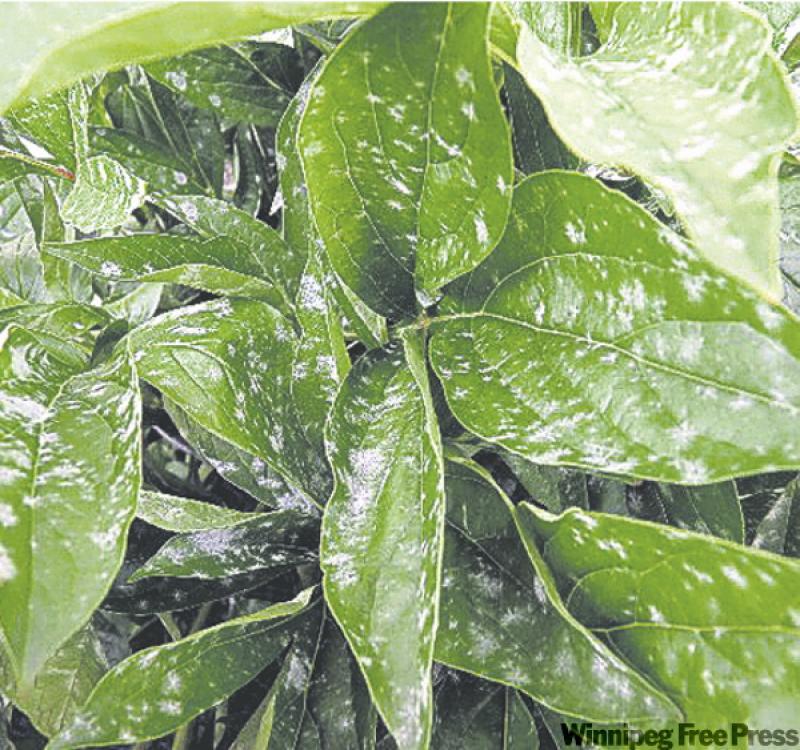

It's prime time for peonies, a perennial favourite in the prairie garden. So, it's only natural I would receive a couple of letters with questions about problems that have cropped up. The last letter's subject is one that arises with new gardeners who may not realize the vast choice of plant options available to us. For those who get discouraged I say try, try again. It was the very successful nurseryman, plant-breeder and author Tony Avent who once said, " I consider every plant hardy until I have killed it myself... at least three times."
Dear Linda:
Thank you very much for writing your informative and educational articles every week. I enjoy your column very much.
I'm writing to ask your advice about a peony problem. I planted 4 peonies about 8 years ago on the east side of the house and up till last year, there was no problem.
Last year, I began noticing that the leaves turned white. I thought it might have to do with over-head watering so this year, I have been careful to water only at the roots.
However, the problem showed up again just as the flowers were budding or about to bloom. I have attached four photos for you to see.
I took a closer look and saw that there was some kind of snowflake type growth on the leaves. Every leaf has the growth. I can also detect a moldy smell around the plants. The flowers are fine but the foliage looks terrible.
I dug up two plants when blooming was over and I'd like to plant something else in their place. I also plan to dig up the other two plants when blooming is done.
Do you know what the problem may be? And do you think it will infect other plants that I plant in this same area? So far, it hasn't affected any other plants on the south and north side of our house. Can you please suggest a good perennial for the east side?
Thank you for taking the time to read this.
-- Choo
It appears your problem is a fungi collectively called powdery mildew. It usually begins as a minor whitish spotting that can be rubbed off and can quickly progress to a powdery coating as the spores multiply. It affects numerous garden plants, each with their own specific fungus. A peony fungus will not infect a rose or a monarda, though all can be prone to powdery-mildew.
The spores are spread by the wind. Conditions favourable for rampant growth include high humidity, low light levels, closely spaced or crowded plants and cool temperatures.
I've read reports that mildew can develop quickly when day and nighttime temperatures are vastly different. Symptoms are usually not fatal, though the condition is unsightly. Stunting or distortion of foliage and flowers plus a general decline of the plant's health can result.
During the winter, the fungus survives on infected plant parts and nearby debris. Prune affected foliage and discard.
A multi-purpose fungicide, neem oil product or horticultural oil may be effective if applied early. Be sure to read and follow directions on the label. Home-made remedies such as potassium bicarbonate (closely related chemically to sodium bicarbonate, or baking soda) suspension or a spray comprised of milk diluted with water may also work. I'd try one of those first.
As for a new plant to try, that's hard to say. There are so many attractive perennials to choose from, I'd suggest you go shopping and pick out a plant that appeals to you keeping in mind its requirements and growth habit.
Hi Linda,
I have a huge peony growing in a sunny location against my house. It looks perfectly healthy except that the leaves are getting a lighter and lighter yellowish-green. Could this be caused by my neighbour's cat using the garden as a bathroom and what can I do to turn it back to a nice dark green?
-- Susan
Sounds like the plant is lacking in some nutrients, particularly nitrogen. But, you don't want to fertilize it with too much nitrogen or it might not flower. A balanced fertilizer in a slow release formula might do the trick. Do you fertilize or add compost to your soil every year?
Also, I would discourage the cats by placing prickly branches or some other barrier on the soil where they go in the hopes they'll find somewhere else to do their business.
Hi Linda,
This is my second attempt to have a perennial on our balcony with not much luck. My last year's attempt was hostas that did not survive the winter. Shelmerdine told me to try bulbs and I purchased a canna lily and planted it in a large container. Our balcony faces west so it gets the afternoon sun. The container is on the ground but has little feet under it but I am wondering if it needs to be higher off the ground. It is not doing well and I've cut off most of the foliage that came with it. New growth is coming but it is tipped in brown and the leaves are very wet. I'm assuming I'm overwatering but the instructions said to water often the first year.
I feel I should just give it up at this point but would welcome any advice you have. Thanks.
-- Darcia
A hosta will not survive the winter in a pot, especially on a balcony. It needs to be in the ground with a good insulating snow cover.
The canna probably needs more sun and probably isn't the best choice for a west balcony. Also it may have root or bulb rot from overwatering.
Balconies are very challenging to grow plants on. (I've got a west-facing balcony myself) Have you thought about putting some tropical houseplants (palms, peace lily, pothos, ferns or flowering hibiscus are just a few) out there that you can grow inside over the winter? I had good luck with dracaenas, but just about any houseplant will do well as long as it is sheltered from high winds.
linda.stilkowski@freepress.mb.ca



